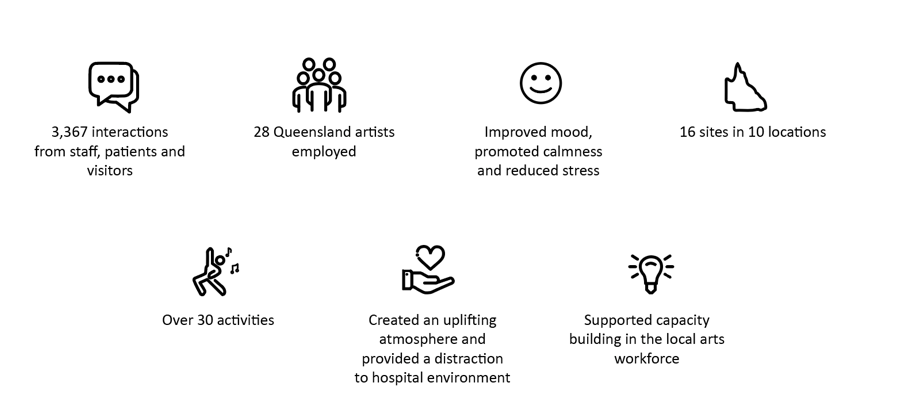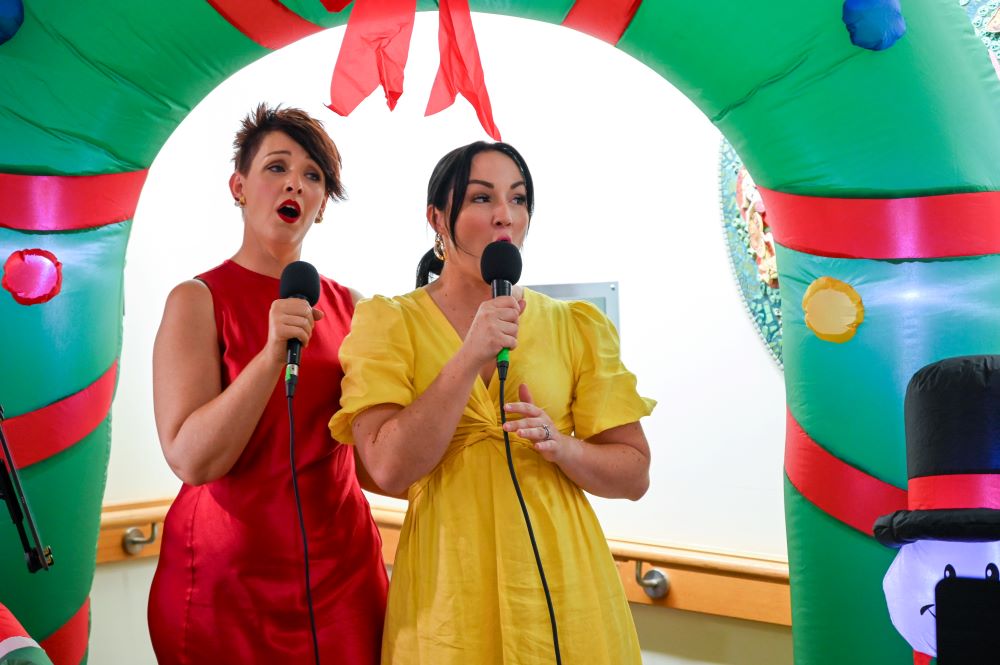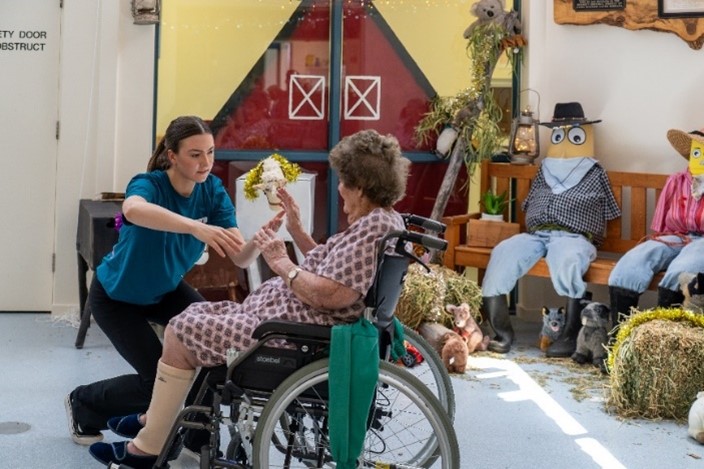
Deck the Wards - A story of joy, hope and belonging
- 9 Sep 2024
Deck the Wards was a multi-arts program, which introduced arts experiences into 10 hospitals and health service facilities in the Wide Bay Hospital and Health Service during December 2023.
Program description
Deck the Wards was a multi-arts program, which introduced arts experiences into 10 hospitals and health service facilities in the Wide Bay Hospital and Health Service (WBHHS) during December 2023. The project aimed to respond to feedback concerning lowered wellbeing experienced by staff, patients, residents and visitors during the festive season due to ill health, feelings of isolation and the clinical nature of health facilities.
Deck the Wards adopted the theme A story of joy, hope and belonging and featured a program of 30 diverse arts activities, including visual arts, music, theatre, and dance, led by 28 Queensland-based artists. Activities provided opportunities for staff and the WBHHS community (patients, residents, and visitors) to engage as audience members or active participants.
A focus on short activities (up to two hours) gave flexibility to program events addressed the unique spaces and needs across the WBHHS.
As the first project in the Arts and Health pilot, Deck the Wards is an example of how arts can be integrated into different locations across the WBBHS, while demonstrating the factors which facilitate success and challenges to be considered.

Method
Development and implementation of the project was led by an Arts Health Consultant employed by WBHHS to lead the Wide Bay Arts in Health Pilot.
The Arts in Health Consultant was supported by WBHHS Governance, Strategy and Planning, Service Transformation and Redesign Team, the Arts in Health Pilot Governance Advisory Committee, local arts industry professionals and staff in hospital and health services across the region.
Project development occurred between September and November 2023, with project delivery in December 2023.
Key steps in development included:
- Consultation: extensive consultation informed the development and focus of the project. Consultation included: a staff survey, a survey of local arts professionals and site visits to 11 facilities in the WBHHS.
- Programming: activity and site locations were selected based on interest of staff in healthcare facilities, population, availability of artists and appropriate space.
- Induction: artists' and arts workers induction occurred prior to the delivery of arts activities. Induction focused on roles and responsibilities in working in a health environment, Code of Conduct training (required by all contractors in health facilities) and employment screening.
- Communication: a targeted suite of communications tools was developed to serve the needs of the programs’ audiences. Messaging for staff focused on the benefits of arts participation for wellbeing in the workplace, whereas messaging for patients and families focused on key themes of the project (joy, fun, community and belonging). All correspondences communicated logistics of the activities.
Data collection and evaluation
Monitoring and data collection included participant counts, observations, standardised tools, staff feedback, photography, videography and artist surveys. Collection methods were reviewed and modified to ensure minimal participant disruption whilst still allowing for collection of data.
Evaluation Findings
Project outcomes

Improvement in wellbeing and connection for the WBHHS staff and community: Artistic activities improved the hospital atmosphere encouraging celebration, uplifting moods, boosting staff morale, promoting calmness and stress reduction. Observers noted increased joy, laughter, smiling, singing, and dancing among participants. Staff and patients expressed appreciation, with comments highlighting the calming and relaxing impact of the activities. Unexpected outcomes included renewed interest in creative activities and staff-initiated arts initiatives.
I can’t remember the last time I laughed so much and by the end of the show my cheeks were sore from the amount of laughter and smiles. – Staff member, Jofus and the Plank (Lily Fish), Maryborough
Increased social interaction were noted by staff and observers across the range of activities programmed, with patients emerging from rooms to participate or observe, visitors pausing to listen, conversations between audience members and involvement in communal activities like singing and clapping. For other patients and residents, activities promoted storytelling and reminiscence which was shared among the group, supporting increased interaction. For example, Christmas carols in the activity in Mundubbera sparked a conversation around traditions at Christmas time, past and present.
Positive impact on the environment: Arts activities positively impacted the environment by creating an uplifting atmosphere, providing a distraction, and improving perceptions of the hospital setting. Staff and patients expressed enjoyment and appreciation for the opportunities to engage with the arts. Observers noted the shift in atmosphere, with curiosity and engagement from onlookers. Active art-making activities aimed at creating works in the hospital environment were well-regarded, as participants felt they were contributing to improving the space.
It’s so much better than just being stuck in your room doing nothing. – Patient, Maryborough
Supported capacity building in the local arts workforce: Approximately 90% of artists reported increased confidence to work in healthcare settings, and 60% noted skill improvements. Artists valued the professional development opportunity, highlighting improved skills in communication, collaboration and adapting to unique healthcare environments. Many expressed a desire to participate in future projects and noted the applicability of their newly acquired skills beyond healthcare settings.
I found it extremely rewarding to be able to create an ongoing activity that suits hospital staff, visitors, inpatients (even and particularly those who can leave their bed) at the same time. The instant excitement and positive feedback is very touching. – Artist, Artists Survey

Key factors contributing to the success of project
-
Arts Health Consultant: the appointment of an Arts Health Consulant was a key factor in the success of the project and was responsible for driving other key success factors. The Consultant oversaw the development and delivery of each activity, leading project management, stakeholder engagement, cultural capability and contracting required across the project. The Consultant also acted as an intermediary between artists and WBHHS staff and was involved in data collection and evaluation.
-
Stakeholder & community codesign: co-design and consultation ensured project activities were tailored to the specific needs and preferences of each location. Involvement of hospital staff and other stakeholders in the design process, created meaningful and engaging activities that resonated with the target audience, enhancing the overall impact and effectiveness of the project.
-
Clear communication: regular communication and pre-event briefings with staff and artists ensured projects ran smoothly.
-
WBHHS staff commitment: commitment by staff to participate and engage in the new project and champion engagement by patients and staff contributed to the impact of the project.
-
Artist and arts workers’ selection: artists and arts workers who displayed flexibility in their approach and an ability to adapt to changing environment worked well across the project.
-
Format of program: the multi-location format worked well in providing opportunities for many community members and staff to participate in activities in their local area across the region.


